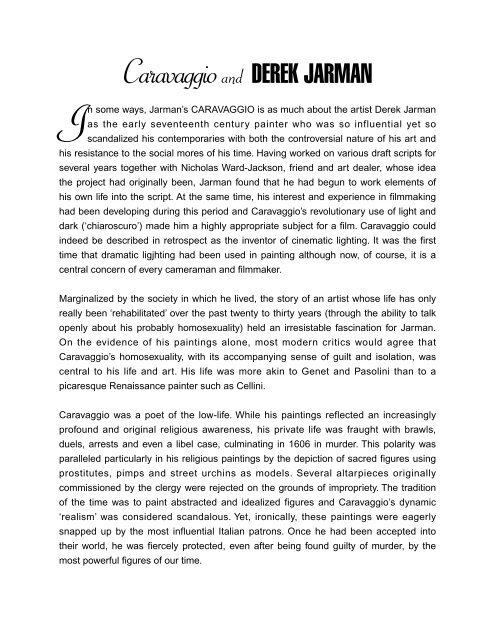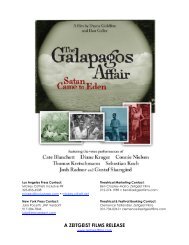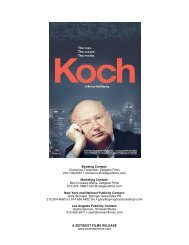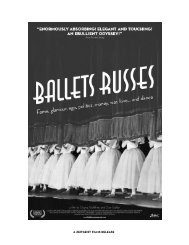Caravaggio Derek Jarman's - Zeitgeist Films.
Caravaggio Derek Jarman's - Zeitgeist Films.
Caravaggio Derek Jarman's - Zeitgeist Films.
Create successful ePaper yourself
Turn your PDF publications into a flip-book with our unique Google optimized e-Paper software.
<strong>Caravaggio</strong> and DEREK JARMAN<br />
In some ways, Jarman’s CARAVAGGIO is as much about the artist <strong>Derek</strong> Jarman<br />
as the early seventeenth century painter who was so influential yet so<br />
scandalized his contemporaries with both the controversial nature of his art and<br />
his resistance to the social mores of his time. Having worked on various draft scripts for<br />
several years together with Nicholas Ward-Jackson, friend and art dealer, whose idea<br />
the project had originally been, Jarman found that he had begun to work elements of<br />
his own life into the script. At the same time, his interest and experience in filmmaking<br />
had been developing during this period and <strong>Caravaggio</strong>’s revolutionary use of light and<br />
dark (‘chiaroscuro’) made him a highly appropriate subject for a film. <strong>Caravaggio</strong> could<br />
indeed be described in retrospect as the inventor of cinematic lighting. It was the first<br />
time that dramatic ligjhting had been used in painting although now, of course, it is a<br />
central concern of every cameraman and filmmaker.<br />
Marginalized by the society in which he lived, the story of an artist whose life has only<br />
really been ‘rehabilitated’ over the past twenty to thirty years (through the ability to talk<br />
openly about his probably homosexuality) held an irresistable fascination for Jarman.<br />
On the evidence of his paintings alone, most modern critics would agree that<br />
<strong>Caravaggio</strong>’s homosexuality, with its accompanying sense of guilt and isolation, was<br />
central to his life and art. His life was more akin to Genet and Pasolini than to a<br />
picaresque Renaissance painter such as Cellini.<br />
<strong>Caravaggio</strong> was a poet of the low-life. While his paintings reflected an increasingly<br />
profound and original religious awareness, his private life was fraught with brawls,<br />
duels, arrests and even a libel case, culminating in 1606 in murder. This polarity was<br />
paralleled particularly in his religious paintings by the depiction of sacred figures using<br />
prostitutes, pimps and street urchins as models. Several altarpieces originally<br />
commissioned by the clergy were rejected on the grounds of impropriety. The tradition<br />
of the time was to paint abstracted and idealized figures and <strong>Caravaggio</strong>’s dynamic<br />
‘realism’ was considered scandalous. Yet, ironically, these paintings were eagerly<br />
snapped up by the most influential Italian patrons. Once he had been accepted into<br />
their world, he was fiercely protected, even after being found guilty of murder, by the<br />
most powerful figures of our time.















